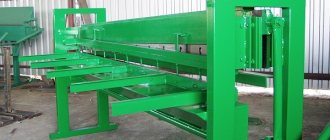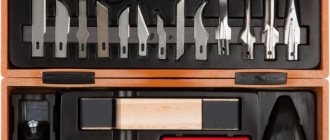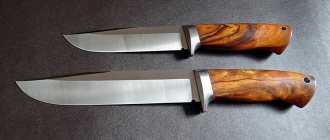On many specialized forums there are serious debates about which valve is better to make a knife from. Should I use inlet or outlet? There was no exact answer. But from reliable sources it becomes clear that it is better to make a valve knife from the outlet version. Since it is designed for higher temperatures and the blade made from it does not require hardening.
Homemade valve knife.
Main characteristics of x40 steel
The most interesting thing is that steel for valves of different technologies is made from different alloys. Cars have one, diesel locomotives have another, for airplanes in general it is probably classified, even ships will have their own alloy special for loads.
And what’s even more interesting is that, taking equipment of the same nature, the valves can also be of different compositions, for example, “Kamaz” and “Zhiguli”.
There are at least a dozen grades of steel, for example: EP 303 55Х20Г9АН4, 45Х14Н14В2М GOST 5632-72, 40Х9С2 GOST 5632-72, 45Х22Н4М3 GOST 5632-72, etc. And taking into account the customer’s specifications, in general, a hundred. But it so happens among the people that the most popular is 40th steel. So let's talk about it.
As the steelmakers and rollers themselves write, this steel is structural alloy. It is used in industry for high-strength products and is prone to temper brittleness. Products made from it have the following characteristics:
- does not rust due to the high chromium content;
- increased hardness is achieved due to the high carbon content;
- the material can be easily obtained, even in a car workshop.
It’s hard to disagree here; indeed, the characteristics have become quite high. But even if you can’t get this particular steel. Metallurgists claim that it can be replaced with the following brands: 45Х, 38ХА, 40ХН, 40ХС, 40ХФ, 40ХР. And this designation is only for domestic production, and there are many foreign analogues.
Main characteristics of X40 steel
When choosing a workpiece for making a knife, you should pay attention to the basic properties of the alloy. The valves are manufactured using X40 steel, which has high performance characteristics. Among the features, the following points can be noted:
- The metal in question is characterized by high heat resistance, which is due to the inclusion of a large number of alloying elements in its composition. The valves operate under difficult operating conditions.
- High mechanical properties are not lost even when exposed to temperatures up to 600 degrees Celsius. That is why valve steel knives have become widespread.
- Prolonged exposure to heat may reduce the toughness rating.
- A high carbon concentration determines that the cutting part of the valve knife wears out slowly.
- The inclusion of chromium in the composition results in the material being characterized by excellent corrosion resistance. This is why dark or yellow spots will not appear on the knife blade from the valve. Surface lubrication is not required during long-term storage of the product.
Characteristics of X40 steel
The above information determines a fairly large distribution of knives from the valve.
However, the basic properties significantly complicate the processing procedure.
Primary processing
The primary processing stage is carried out in order to give the workpiece a primary shape that will approximately resemble the final product. The preparatory stage is characterized by the following features:
- The workpiece is forged.
- The structure of the material is compacted.
The above information determines that a knife from a valve can only be made if you have the skills of a blacksmith. In addition, appropriate equipment is required, which is used to heat the material and deform it.
Valve - steel grade?
I ask for help: they unfastened the locomotive valve, but it is rusting. Who knows the steel grade? Tell. Please do not send to the search (traffic + politics. ). The sheaf of sparks on the sandpaper is dense, dark red. I would be grateful for your advice - is it worth the trouble?
Of course it’s worth it, the steel is excellent, if you polish it like a mirror it won’t rust. It is called chromium-silicon-molybdenum heat-resistant steel 40Х10С2М or EI107.
Well, there are at least 10 brands of them. for example, steel EP 303 55Х20Г9АN4 Steel 45Х14Н14В2М GOST 5632-72 Steel 40Х9С2 GOST 5632-72 Steel 45Х22Н4М3 GOST 5632-72
and so on .. well, I hope they haven’t banned you from Google? (c)
Only the one on the INTAKE is used for the knife! Which is NOT suitable for graduation!
Comrade Zaicheg, thank you for the information! Mr. Serjant, please accept my gratitude! Please explain what a ghoul (gul, ghoul.) is and why he (her.) cannot be banned? Sincerely, Kalmuik. PS The strip turned out to be quite good: 500x35x8-3. Of course, there is a lot of work, but if the steel is worth it, it will be a joy. GAU-8A - They said that the valve was INTAKE, but I heard different opinions on this matter. The stainless steel itself, incl. I check the valves with a magnet. Thanks everyone!
Remember this for life. The valve must be EXHAUST for the simple reason that it operates under much more severe conditions. The exhaust gases have a higher temperature, which is due to the higher quality of the valve material compared to the intake, where fuel and gas (air) are supplied cold.
Interesting information, but Maryanko says it the other way around. Where is the truth?
The exhaust gases have a higher temperature, which is due to the higher quality valve material compared to the intake
to Serjant: 1. I think there needs to be a discussion about this and put it in the FAQ. 2. The statement that only graduation is, in my amateur opinion, incorrect, although before this I thought exactly the opposite. They say that the exhaust valve does not get hot precisely because it is heat-resistant, there is little carbon there, and there are a lot of alloying additives. to kalmuik: If the strip is long, then perhaps it was forged from the valve stem, and not from the head. Because it is more difficult to forge from the head. But the rod uses a completely different steel if the valve is large. That is there is one steel on the head, and another on the stem. Therefore, find out from which part it was forged. If from the stem, then the type of valve is not important. Sincerely
Serjant
better quality valve material compared to the intake valve, where fuel and gas (air) are supplied cold.
Well, the intake also heats up over 500K.
What does “better quality” mean?
Interesting. At my work, a guy has an unforged strip, and now he’s also making a knife for himself. Is it true that it is supposedly “hardening” and that there is no need to heat it? If so, how to process it, what hardness does the strip have? What is the general advantage of this steel? (I live near the station, I can get it!)
The stainless steel itself, incl. I check the valves with a magnet. Thanks everyone!
GAU-8A
Of course, you may not remember it for the rest of your life, but forget it right away, but EXHAUST valves are made of chrome-nickel-tungsten steel and it does not tolerate hardening. Read Maryanko.
Oh my goodness, I wonder why dozens of personally forged exhaust valves from a wide variety of equipment were hardened. Many are still in use, for 20 years now.
I don’t give a fuck about Maryanko or anyone else with their opinions, I have personal opinions and facts. You need to be able to harden.
Sergeant and anatoly +1000
Inlet. 500K. After all, it will shoot into the carburetor!










